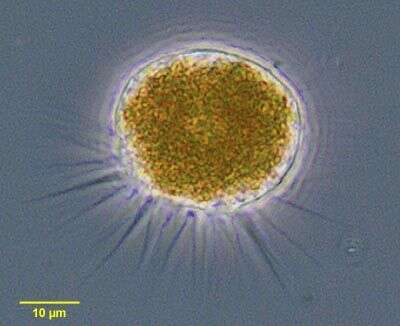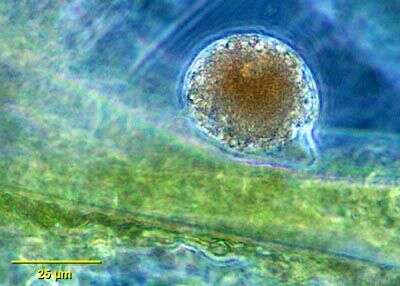-
Vampyrellid filose amoeba. Unidentified, but because it has fine pseudopodia, granular cytoplasm and a tinge of yellow or orange colour it is identified as a vampyrellid amoeba - amoebae which are associated with feeding on fungi and algae in terrestrial and freshwater ecosystems respectively. The terrestrial fungivorous taxa are usually assigned to Arachnula, and the freshwater algivorous species to Vampyrella. Both genera are reported to attach to the outside of their prey, to cut little trap doors in the surrounding walls, and they then throw away the trapdoors before consuming the cytoplasm that then flows out. They have been argued to have potential in controlling some plant pathogenic fungal disorders. Phase contrast.
-
-
-
-
Vampyrella, classified currently with the amoebae of uncertain affinities (formerly included with the filose amoebae). Cells may be rounded with few pseudopodia or more flattened with fine branching pseudopodia. The cytoplasm is orange to pinkish in color with numerous granules, which obscure the nucleus, and contractile vacuole in these images. Vampyrella is algivorous, feeding on filamentous algae. The amoeba drills a small hole in the algal cell wall and consumes the contents. From freshwater pond near Boise, Idaho. Phase contrast.
-
Vampyrella, classified currently with the amoebae of uncertain affinities (formerly included with the filose amoebae). Cells may be rounded with few pseudopodia or more flattened with fine branching pseudopodia. The cytoplasm is orange to pinkish in color with numerous granules which obscure the nucleus and contractile vacuole in these images. Vampyrella is algivorous, feeding on filamentous algae as seen in this image. The amoeba drills a small hole in the algal cell wall and consumes the contents. From freshwater pond near Boise, Idaho. Phase contrast.













